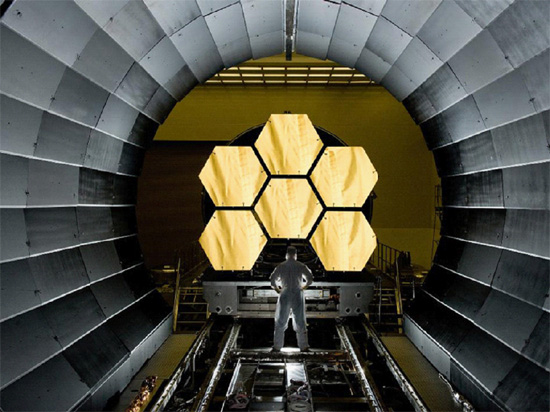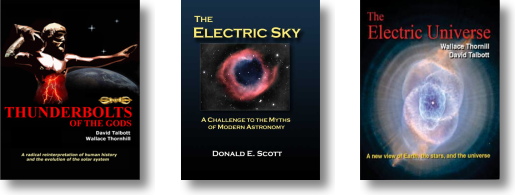
The first six of eighteen beryllium mirror segments ready for cryogenic testing. Credit: NASA/MSFC/David Higginbotham
Sep 19, 2011
The telescope that was once thought to be canceled has escaped mothballs and is on track for launch.
The James Webb Space Telescope (JWST), formerly The Next Generation Telescope, is scheduled to be launched sometime in 2018. According to a report in Aviation Week & Space Technology, total cost for the five year mission will be around $8.7 billion.
JWST is designed to explore the cosmos in infrared wavelengths, with a mirror larger than any ever flown: 6.5 meters. Due to its large size, the mirror is constructed of 18 hexagons made of beryllium, mounted to a lightweight framework. Each mirror segment is finished with a 3.5 gram coating of pure gold. Since gold is an excellent infrared reflector, the JWST’s mirror will be 98% reflective, compared to the Hubble Space Telescope’s optical mirror at 85%, providing a much more efficient light-gathering capability.
Infrared radiation (or light) is typically characterized as wavelengths longer than the .4 to .7 micron range of visible light. Infrared is divided into three regions: near-infrared (.7 to 5 microns), mid-infrared (6 to 30 microns), and the far infrared (30 to 1000 microns). The JWST detectors are most sensitive to the near and mid-infrared ranges.
It is difficult to see infrared radiation unless the devices used are extremely cold. Warm objects radiate heat, which is infrared light, so if the JWST’s mirror were the same temperature as Hubble’s, for example, any faint radiation from distant sources would be drowned out by the emissions given off by the mirror, itself. Consequently, Webb’s mirrors must be kept near -220 C, so it will be sent into an orbit around the L2 LaGrange point, 1.5 million kilometers from Earth. There, sunshields will also keep the mirrors in permanent shade.
French mathematician Louis Lagrange discovered the points that bear his name while conducting “three body” gravitational studies, that is, how a small third body orbits two large bodies in orbit around each other. Lagrange points are regions of space where gravity and orbital motion are in balance. There are LaGrange points in the Earth-Sun system.
The closer a planet is to the Sun, the faster it revolves. A spacecraft revolving around the Sun in a shorter orbit than Earth will overtake our planet, so it cannot maintain a fixed, relative station. However, if it is placed between the Sun and Earth at just the right distance, it will take one year to orbit the Sun and it will stay in a fixed position relative to the Earth. This is called the L1 LaGrange point and is best for solar observatories like SOHO, although it is an unstable position and requires frequent rocket engine corrections.
L2, on the other hand, is on the opposite side of Earth from the Sun, about 1.5 million kilometers distance from us. Any spacecraft launched to that point would orbit more slowly than the Earth. The increased gravitational attraction of the Earth adds to that of the Sun, allowing the JWST, for instance, to go faster and to keep up, with an orbital period equal to Earth’s. It too is unstable, however.
The James Webb Space Telescope could be a valuable tool for Electric Universe advocates. One of the theoretical considerations being discussed in those circles is the habitat around brown dwarf stars. It has been proposed that brown dwarfs could be one of the most numerous stellar categories, but they cannot be adequately studied with current technologies. Even the Spitzer Space Telescope, whose onboard tank of liquid helium coolant has been exhausted, was able to capture only a few images. One tantalizing specimen was estimated to be a mere 27 C, prompting the need for a more detailed and long-term analysis of that population.
As Wal Thornhill wrote: “All stars are an electrical phenomenon. There are no ‘misfits’ in an Electric Universe. All of the assumptions being heaped upon the meagre photons received from deep space merely serve, as usual, to force fit the data to the standard model of stars. The very name, brown ‘dwarf’, assumes that these stars are ‘compact balls of gas floating freely in space’. In stark comparison, the electric model describes them as ‘huge’ because the light from a star is a plasma discharge phenomenon with only a loose relationship to the physical size of the star and a strong dependence on the electrical environment.”
Stephen Smith
Thunderbolts of the Gods, by David Talbott and Wallace Thornhill, introduces the reader to an age of planetary instability and earthshaking electrical events in ancient times. If their hypothesis is correct, it could not fail to alter many paths of scientific investigation.
More info
The Electric Sky. Professor of electrical engineering Donald Scott systematically unravels the myths of “Big Bang” cosmology, and he does so without resorting to black holes, dark matter, dark energy, neutron stars, magnetic “reconnection,” or any other fictions needed to prop up a failed theory.
More info
The Electric Universe. In language designed for scientists and non-scientists alike, authors Wallace Thornhill and David Talbott show that even the greatest surprises of the space age are predictable patterns in an electric universe.
More info













